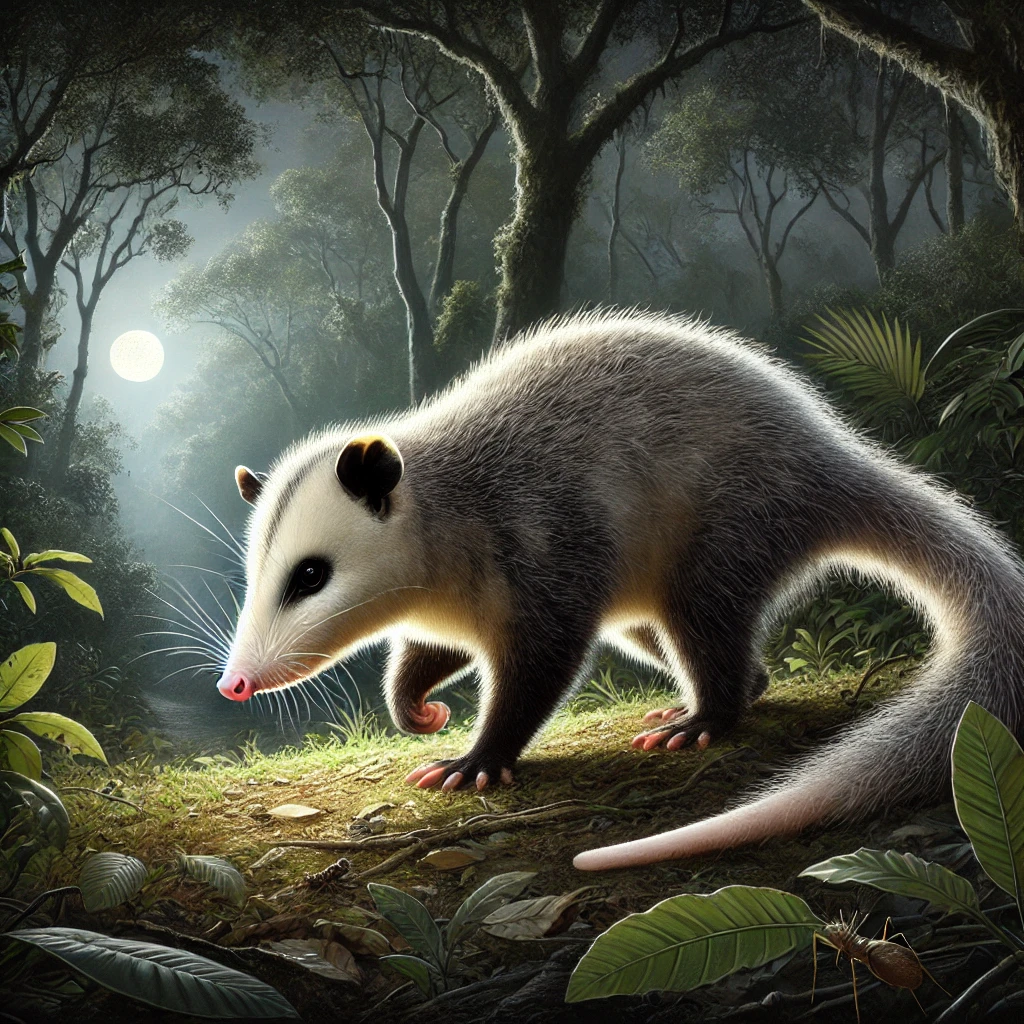The Tlacuache: Mexico’s Little Marsupial Friend
The tlacuache, also known as the Mexican opossum or tlacuatzin in the Nahuatl language, is one of the most unique animals in Mexico. Many people think it is just a big rat or a pest, but the tlacuache is actually a very important part of nature. It helps control insects, clean the environment, and even appears in old Mexican legends. The tlacuache is a unique mammal found in Mexico and other parts of the Americas. Even though people sometimes write it as “Tñacuache”, it refers to the same creature. It is often misunderstood, yet it plays a key role in nature and culture.
This article explains what the tlacuache is, what it looks like, where it lives, how it behaves, and why it is so important to both the ecosystem and Mexican culture.
1. Classification
The tlacuache belongs to a group of animals called marsupials. Marsupials are mammals that carry their babies in a pouch, like kangaroos in Australia.
Scientific classification:
| Category | Name |
|---|---|
| Order | Didelphimorphia |
| Family | Didelphidae |
| Common species in Mexico | Didelphis marsupialis (Common opossum), Tlacuatzin canescens (Mouse opossum) |
The word “tlacuache” comes from the Nahuatl language and can mean “little eater.” It shows how old and important this animal is in Mexican history.

2. Physical Description
The tlacuache’s body has many special features that help it live in trees and survive in cities and forests.
Main features:
-
Pointed nose and big ears
-
Long, almost hairless tail that can hold on to branches (prehensile tail)
-
Five fingers on each paw, and a thumb that helps it grab things
-
Sharp teeth for eating many kinds of food
-
Fur color from gray to brown depending on the species
Size comparison table:
| Species | Average Weight | Body + Tail Length | Notable Traits |
|---|---|---|---|
| Didelphis marsupialis | 1–2 kg | 30–40 cm + 30–40 cm tail | Common in cities and rural areas |
| Tlacuatzin canescens | < 1 kg | 20 cm + 20 cm tail | Smaller, lives in dry forests |
Because of its long face and tail, people often mistake the tlacuache for a rat. But it is completely different — it’s the only native marsupial in Mexico.
3. Habitat and Distribution
Tlacuaches live almost everywhere in Mexico — from jungles and forests to cities and towns. They adapt very well to new environments.
Common habitats:
-
Tropical rainforests
-
Dry forests and woodlands
-
Farms and crop areas
-
Urban neighborhoods and gardens
They are nocturnal, which means they come out mostly at night. You might see one walking along a wall, climbing a tree, or searching for food in the trash. During the day, they hide in quiet places like holes, roofs, or piles of leaves.
4. Behavior and Ecology
The tlacuache is a very flexible and smart animal. It can survive in many different conditions and eats almost anything.
What they eat:
-
Insects
-
Fruits and seeds
-
Small animals and eggs
-
Carrion (dead animals)
-
Food waste from humans
Because of this diet, the tlacuache helps clean the environment and reduce pests such as insects and rodents.
Behavior facts:
-
They are loners; they usually live alone.
-
They are nocturnal (active at night).
-
They can play dead to scare away predators — this trick is called “thanatosis.”
-
They use their tail to climb and balance.
-
They move slowly but are excellent climbers.
Table: Ecological roles
| Role | How it helps nature |
|---|---|
| Seed disperser | Spreads seeds after eating fruit |
| Pest control | Eats insects and small rodents |
| Prey | Food for owls, foxes, and snakes |
| Scavenger | Cleans up dead animals |
5. Reproduction and Life Cycle
The tlacuache is famous for its special way of raising babies.
Reproduction steps:
-
The female gives birth to very tiny, underdeveloped babies after a short pregnancy (about 13 days).
-
The babies crawl into the pouch on the mother’s belly.
-
Inside the pouch, they continue growing for about 2–3 months.
-
When they are bigger, they climb onto their mother’s back and hold on while she moves.
-
After a few more weeks, the young tlacuaches can live on their own.
Quick facts:
-
A mother can have 8 to 14 babies at once.
-
Only a few babies usually survive to adulthood.
-
They can reproduce several times a year.
-
Their total lifespan is 2–4 years in the wild.
6. Tlacuache and Humans
Tlacuaches live close to people, especially in towns and cities. Sadly, many people think they are dirty or dangerous, which is not true.
Common myths and truths:
| Myth | Reality |
|---|---|
| Tlacuaches are rats. | They are marsupials, a completely different group of animals. |
| They spread diseases. | Very rare; their body temperature is too low for rabies to survive. |
| They are pests. | They help control real pests like insects and mice. |
Tips to live peacefully with tlacuaches:
-
Don’t try to hurt or catch them.
-
Close trash cans tightly to avoid attracting them.
-
Don’t keep them as pets — they belong in the wild.
-
If one enters your house, gently open a path for it to leave.
They are shy animals and only defend themselves if they feel cornered.
7. Cultural Importance
The tlacuache is more than just a wild animal — it has deep cultural meaning in Mexico.
In Mexican legends:
-
In ancient Nahuatl stories, the tlacuache stole fire from the gods and gave it to humans.
-
Because of this, some say its tail lost its fur as punishment.
-
It represents cleverness and courage in many tales.
The animal appears in Aztec and Mixtec art and continues to be a part of folklore in many parts of the country.
8. Conservation and Threats
Most tlacuache species are not endangered, but they still face several dangers caused by humans.
Main threats:
-
Loss of habitat due to deforestation and city growth
-
Road accidents
-
Being killed because people mistake them for pests
-
Attacks by dogs and cats
Conservation efforts:
-
Environmental education to teach people that tlacuaches are helpful
-
Protection of forests and natural areas
-
Rescue and release programs for injured tlacuaches
Table: Threats vs. Protection Actions
| Threat | Possible Solution |
|---|---|
| Deforestation | Reforestation and protection of natural areas |
| Roadkill | Wildlife crossings and warning signs |
| Misinformation | Public education campaigns |
| Domestic animals | Keeping pets under control at night |
9. Fun Facts
-
The tlacuache is the only native marsupial in Mexico.
-
It has lived in the Americas for millions of years.
-
It can hang by its tail, but only for short moments.
-
It rarely gets rabies, thanks to its low body temperature.
-
Its droppings can actually help new plants grow by spreading seeds.
-
When scared, it can release a bad smell to protect itself.
10. Why the Tlacuache Matters
The tlacuache plays a big role in Mexico’s ecosystems and history.
It keeps the balance of nature by eating pests, spreading seeds, and cleaning up waste.
In cities, it helps reduce garbage and insects naturally — without chemicals.
It also connects people to their roots, reminding us of the stories and respect ancient cultures had for the natural world.
11. Conclusion
The tlacuache is not a dirty or scary animal — it is a smart, gentle, and helpful creature. It teaches us about adaptation, survival, and balance with nature. When you see a tlacuache walking on your wall or garden at night, remember: It is a small guardian of the ecosystem, a symbol of Mexico’s biodiversity, and a quiet reminder of our connection to nature.
The tlacuache (Tñacuache) is more than an odd creature in the night. It is a clever, adaptable, and beneficial mammal. By understanding it, we see how it fits into nature, how it lives near us, and how we can share spaces more kindly. Next time you spot one, remember: there’s much more to it than meets the eye.
